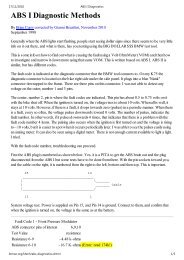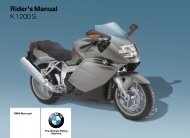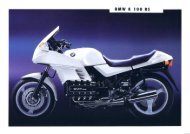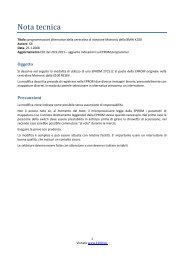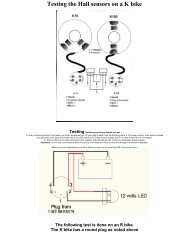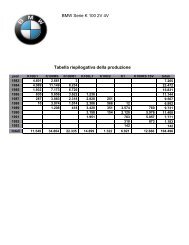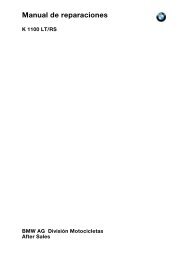Rider's Manual K 1200 R - K100.biz
Rider's Manual K 1200 R - K100.biz
Rider's Manual K 1200 R - K100.biz
Create successful ePaper yourself
Turn your PDF publications into a flip-book with our unique Google optimized e-Paper software.
6<br />
82<br />
Engineering details<br />
z<br />
Brake system with<br />
BMW Motorrad Integral<br />
ABS OE<br />
Partially integral brakes<br />
Your motorcycle is equipped with<br />
partially integral brakes. Both<br />
front and rear brakes are applied<br />
when you pull the handbrake<br />
lever. The footbrake lever acts<br />
only on the rear brake.<br />
While the brakes are slowing the<br />
motorcycle, the BMW Motorrad<br />
Integral ABS adapts braking-force<br />
distribution between front and<br />
rear brakes to suit the load on<br />
the motorcycle.<br />
The integral braking function<br />
makes it very difficult<br />
to spin the rear wheel by opening<br />
the throttle with the front brake<br />
applied to keep the motorcycle<br />
stationary (burn-out). Attempted<br />
burn-outs can result in damage<br />
to the rear brake and the clutch.<br />
Do not attempt burn-outs.<br />
How does ABS work?<br />
The amount of braking force that<br />
can be transferred to the road<br />
depends on factors hat include<br />
the coefficient of friction of the<br />
road surface. Loose stones, ice<br />
and snow or a wet road all have<br />
much lower coefficients of friction<br />
than a clean, dry asphalt surface.<br />
The lower the coefficient<br />
of friction, the longer the braking<br />
distance.<br />
If the rider increases braking<br />
pressure to the extent that braking<br />
force exceeds the maximum<br />
transferrable limit, the wheels<br />
start to lock and the motorcycle<br />
loses its directional stability; a fall<br />
is imminent. Before this situation<br />
can occur, ABS intervenes and<br />
adapts braking pressure to the<br />
maximum transferrable braking<br />
force, so the wheels continue<br />
to turn and directional stability<br />
is maintained irrespective of the<br />
condition of the road surface.<br />
What are the effects of<br />
surface irregularities?<br />
Humps and surface irregularities<br />
can cause the wheels to<br />
lose contact temporarily with the<br />
road surface; if this happens the<br />
braking force that can be transmitted<br />
to the road can drop to<br />
zero. If the brakes are applied<br />
under these circumstances the<br />
ABS has to reduce braking force<br />
to ensure that directional stability<br />
is maintained when the<br />
wheels regain contact with the<br />
road surface. At this instant the<br />
BMW Motorrad Integral ABS<br />
must assume an extremely low<br />
coefficient of friction, so that the<br />
wheels will continue to rotate under<br />
all imaginable circumstances,<br />
because this is the precondition<br />
for ensuring directional stability.<br />
As soon as is registers the actual<br />
circumstances, the system<br />
reacts instantly and adjusts brak-




